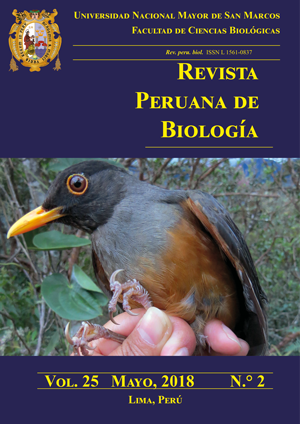Two new species in the Drosophila flavopilosa and Drosophila morelia species groups (Diptera: Drosophilidae) in the eastern Andes of Ecuador
DOI:
https://doi.org/10.15381/rpb.v25i2.14684Keywords:
Cloud forest, biodiversity, Napo province, Papallacta Lake, new species.Abstract
One species in the Drosophila flavopilosa species group and another in the Drosophila morelia species group (Diptera: Drosophilidae) are described and illustrated. The larvae of the flies in these groups develop exclusively in flowers and, usually, are rarely collected from rotten plant parts. However, in this case, these new species were not collected from flowers but were captured with fermented banana and yeast. It indicates that this species may be attracted to the odors of yeast fermentation and not only solanaceous flowers. The specimens were collected at 3362 m above sea level. There are four species of the Drosophila flavopilosa species group and one species of the Drosophila morelia species group previously described from Ecuador. The new species are: Drosophila pseudokorefae sp. nov. in the Drosophila flavopilosa species group and Drosophila pseudomorelia sp. nov. in the Drosophila morelia species group.Downloads
Downloads
Published
Issue
Section
License
Copyright (c) 2018 Emily Ramos Guillín, Violeta Rafael

This work is licensed under a Creative Commons Attribution-NonCommercial-ShareAlike 4.0 International License.
AUTHORS RETAIN THEIR RIGHTS:
a. Authors retain their trade mark rights and patent, and also on any process or procedure described in the article.
b. Authors retain their right to share, copy, distribute, perform and publicly communicate their article (eg, to place their article in an institutional repository or publish it in a book), with an acknowledgment of its initial publication in the Revista Peruana de Biologia.
c. Authors retain theirs right to make a subsequent publication of their work, to use the article or any part thereof (eg a compilation of his papers, lecture notes, thesis, or a book), always indicating its initial publication in the Revista Peruana de Biologia (the originator of the work, journal, volume, number and date).






